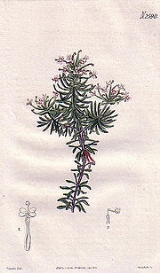
Stylidium adnatum
Encyclopedia
Stylidium adnatum is a dicotyledon
ous plant
that belongs to the genus
Stylidium (family Stylidiaceae
). S. adnatum is endemic
to Australia
and is found primarily in the southwest
region of Western Australia
.
This species is leafy-stemmed and scrambling, growing up to 10 cm tall with leaves to 3 cm long and 5 mm wide. It blooms in late winter and spring with small (3–4 mm wide), white flowers that bear red stripes. S. adnatum is primarily found in jarrah and karri forests, among reeds of paperbark
swamps, and in heath
by streams entering the ocean. Stylidium adnatum var.
abbreviatum (Benth.
, 1868) is a variety of this species found in wild populations and is noted for its short and dense inflorescence
. The variety was discovered and named twice, the second being S. adnatum var. propinquum (R. Br.
), though this name is no longer used.
Dicotyledon
The dicotyledons, also known as dicots, are a group of flowering plants whose seed typically has two embryonic leaves or cotyledons. There are around 199,350 species within this group...
ous plant
Plant
Plants are living organisms belonging to the kingdom Plantae. Precise definitions of the kingdom vary, but as the term is used here, plants include familiar organisms such as trees, flowers, herbs, bushes, grasses, vines, ferns, mosses, and green algae. The group is also called green plants or...
that belongs to the genus
Genus
In biology, a genus is a low-level taxonomic rank used in the biological classification of living and fossil organisms, which is an example of definition by genus and differentia...
Stylidium (family Stylidiaceae
Stylidiaceae
The family Stylidiaceae is a taxon of dicotyledonous flowering plants. It consists of five genera with over 240 species, most of which are endemic to Australia and New Zealand. Members of Stylidiaceae are typically grass-like herbs or small shrubs and can be perennials or annuals...
). S. adnatum is endemic
Endemic (ecology)
Endemism is the ecological state of being unique to a defined geographic location, such as an island, nation or other defined zone, or habitat type; organisms that are indigenous to a place are not endemic to it if they are also found elsewhere. For example, all species of lemur are endemic to the...
to Australia
Australia
Australia , officially the Commonwealth of Australia, is a country in the Southern Hemisphere comprising the mainland of the Australian continent, the island of Tasmania, and numerous smaller islands in the Indian and Pacific Oceans. It is the world's sixth-largest country by total area...
and is found primarily in the southwest
Southwest Australia
Southwest Australia is a biodiversity hotspot that includes the Mediterranean forests, woodlands, and scrub ecoregions of Western Australia. The region has a wet-winter, dry-summer Mediterranean climate, one of five such regions in the world...
region of Western Australia
Western Australia
Western Australia is a state of Australia, occupying the entire western third of the Australian continent. It is bounded by the Indian Ocean to the north and west, the Great Australian Bight and Indian Ocean to the south, the Northern Territory to the north-east and South Australia to the south-east...
.
This species is leafy-stemmed and scrambling, growing up to 10 cm tall with leaves to 3 cm long and 5 mm wide. It blooms in late winter and spring with small (3–4 mm wide), white flowers that bear red stripes. S. adnatum is primarily found in jarrah and karri forests, among reeds of paperbark
Melaleuca
Melaleuca is a genus of plants in the myrtle family Myrtaceae known for its natural soothing and cleansing properties. There are well over 200 recognised species, most of which are endemic to Australia...
swamps, and in heath
Heath (habitat)
A heath or heathland is a dwarf-shrub habitat found on mainly low quality acidic soils, characterised by open, low growing woody vegetation, often dominated by plants of the Ericaceae. There are some clear differences between heath and moorland...
by streams entering the ocean. Stylidium adnatum var.
Variety (biology)
In botanical nomenclature, variety is a taxonomic rank below that of species: as such, it gets a three-part infraspecific name....
abbreviatum (Benth.
George Bentham
George Bentham CMG FRS was an English botanist, characterized by Duane Isely as "the premier systematic botanist of the nineteenth century".- Formative years :...
, 1868) is a variety of this species found in wild populations and is noted for its short and dense inflorescence
Inflorescence
An inflorescence is a group or cluster of flowers arranged on a stem that is composed of a main branch or a complicated arrangement of branches. Strictly, it is the part of the shoot of seed plants where flowers are formed and which is accordingly modified...
. The variety was discovered and named twice, the second being S. adnatum var. propinquum (R. Br.
Robert Brown (botanist)
Robert Brown was a Scottish botanist and palaeobotanist who made important contributions to botany largely through his pioneering use of the microscope...
), though this name is no longer used.

